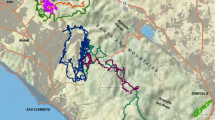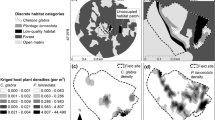Abstract
Habitat isolation can affect the distribution and abundance of wildlife, but it is an ambiguous attribute to measure. Presumably, isolation is a characteristic of a habitat patch that reflects how spatially inaccessible it is to dispersing organisms. We identified four isolation metrics (nearest-neighbor distance, Voronoi polygons, proximity index, and habitat buffers) that were representative of the different families of metrics that are commonly used in the literature to measure patch isolation. Using simulated data, we evaluated the ability of each isolation metric to predict animal dispersal. We examined the simulated movement of organisms in two types of landscapes: an artificially-generated point-pattern landscapes where patch size and shape were consistent and only the arrangement of patches varied, and realistic landscapes derived from a geographic information system (GIS) of forest-vegetation maps where patch size, shape, and isolation were variable. We tested the performance of the four isolation metrics by examining the strength of the correlation between observed immigration rate in the simulations and each patch isolation metric. We also evaluated whether each isolation metric would perform consistently under varying conditions of patch size/shape, total amount of habitat in the landscape, and proximity of the patch to the landscape edge. The results indicate that a commonly-used distance-based metric, nearest-neighbor distance, did not adequately predict immigration rate when patch size and shape were variable. Area-informed isolation metrics, such as the amount of available habitat within a given radius of a patch, were most successful at predicting immigration. Overall, the use of area-informed metrics is advocated despite the limitation that these metrics require parameterization to reflect the movement capacity of the organism studied.
Similar content being viewed by others
References
Andrén H. 1994. Effects of habitat fragmentation on birds and mammals in landscapes with different proportions of suitable habitat: A review. Oikos 71: 355–366.
Bender D.J. 2000. Wildlife Movement in Fragmented Habitats: The Influence of Landscape Complexity. PhD Dissertation, Carleton University, Ottawa, Ontario, Canada.
Bolger B.M., Alberts A.C., Sauvajot R.M., Potenza P., McCalvin C., Tran D. et al. 1997. Response of rodents to habitat fragmentation in coastal southern California. Ecological Applications 7: 552–563.
Bowman J., Jaeger J.A. and Fahrig L. Dispersal distance of mammals is proportional to home range size. Ecology (in press).
Brennan J.M., Bender D.J., Contreras T.A. and Fahrig L. 2002. Experimental design for management at a landscape scale. In: Lui J. and Taylor W.A. (eds), Integrating Landscape Ecology into Natural Resource Management. Cambridge University Press, Cambridge, UK (in press).
Cappuccino N. and Martin M. 1997. The birch tube-maker Acrobasis betulella in a fragmented habitat: the importance of patch isolation and edges. Oecologia 110: 69–76.
de Vries H.H., den Boer P.J. and van Dijk T.S. 1996. Ground beetle species in heathland fragments in relation to survival, dispersal, and habitat preference. Oecologia 107: 332–342.
Delin A.E. and Andrén H. 1999. Effects of habitat fragmentation on Eurasian red squirrel (Sciurus vulgaris) in a forest landscape. Landscape Ecology 14: 67–71.
Diamond J.M. 1975. The island dilemma: Lessons from modern biogeographic studies for the design natural reserves. Biological Conservation 7: 129–146.
Diggle P.J. 1983. Statistical Analysis of Spatial Point Patterns. Academic Press, London, UK.
Doak D.E. and Mills L.S. 1994. A useful role for theory in conservation. Ecology 75: 615–626.
Dunning J.B., Borgella R., Clements K. and Meffe G.K. 1995. Patch isolation, corridor effects, and colonization by a resident sparrow in a managed pine woodland. Conservation Biology 9: 542–550.
Elkie P.C., Rempel R.S. and Carr A.P. 1999. Patch Analyst User’s Manual: A Tool for Quantifying Landscape Structure. Ontario Ministry of Natural Resources. Technical Manual TM-002 TM-002. Northwest Science & Technology, Thunder Bay, Ontario, Canada.
Fitzgibbon C.D. 1993. The distribution of grey squirrel dreys in farm woodland: the influence of wood area, isolation and management. Journal of Applied Ecology 30: 736–742.
Fitzgibbon C.D. 1997. Small mammals in farm woodlands: the effects of habitat, isolation and surrounding land-use patterns. Journal of Applied Ecology 34: 530–539.
Grashof-Bokdam C. 1997. Forest species in an agricultural landscape in the Netherlands: effects of habitat fragmentation. Journal of Vegetation Science 8: 21–28.
Gustafson E.J. 1998. Quantifying spatial pattern: What is state of the art? Ecosystems 1: 143–156.
Gustafson E.J. and Parker G.R. 1992. Relationships between land-cover proportion and indices of landscape spatial pattern. Landscape Ecology 7: 101–110.
Gustafson E.J. and Parker G.R. 1994. Using an index of habitat patch proximity for landscape design. Landscape and Urban Planning 29: 117–130.
Hanski I. 1998. Metapopulation dynamics. Nature 396: 41–49.
Hanski I. and Gilpin M. 1991. Metapopulation dynamics: Brief history and conceptual domain. Biological Journal of the Linnean Society 42: 3–16.
Hanski I. and Ovaskainen O. 2000. The metapopulation capacity of a fragmented landscape. Nature 404: 755–758.
Hansson L. 1998. Local hot spots and their edge effects: small mammals in oak-hazel woodland. Oikos 81: 55–62.
Hargis C., Bissonette J. and David J. 1998. The behavior of landscape metrics commonly used in the study of habitat fragmentation. Landscape Ecology 13.
Harrison R.L. 1992. Toward a theory of inter-refuge corridor design. Conservation Biology 6: 293–295.
Hill J.K., Thomas C.D. and Lewis O.T. 1996. Effects of habitat patch size and isolation on dispersal by Hesperia comma butterflies: implications for metapopulation structure. Journal of Animal Ecology 65: 725–735.
Hjermann D.O. and Ims R.A. 1996. Landscape ecology of the wart-biter Decticus verrucivorus in a patchy landscape. Journal of Animal Ecology 65: 768–780.
Hokit D.G., Stith B.M. and Branch L.C. 1999. Effects of landscape structure in Florida scrub: a population perspective. Ecological Applications 9: 124–134.
Johannesen E., Andreassen H.P. and Ims R.A. 2000. The effect of patch isolation on reproductive synchrony in the root vole. Oikos 89: 37–40.
Kareiva P. 1990. Population dynamics in spatially complex environments: theory and data. Philosophical Transactions of the Royal Society of London, Series B 330: 175–190.
Kinnunen H., Järveläinen K., Pakkala T. and Tiainen J. 1996. The effect of isolation on the occurence of farmland carabids in a fragmented landscape. Annual Zoological Fennici 33: 165–171.
Kozakiewicz M. 1985. The role of habitat isolation in formation of structure and dynamics of the bank vole population. Acta Theriologica 30: 193–209.
Krebs C.J. 1989. Ecological Methodology. Harper, New York, New York, USA.
Laan R. and Verboom B. 1990. Effects of pool size and isolation on amphibian communities. Biological Conservation 54: 251–262.
Levins R. 1970. Extinction. In: Gerstenhaber M. (ed.), Some Mathematical Questions in Biology. The American Mathematical Society, Providence, Rhode Island, USA, pp. 77–107.
Luiselli L. and Capicci D. 1997. Influences of area, isolation and habitat features on distribution of snakes in mediterranean fragmented woodland. Biodiversity and Conservation 6: 1339–1351.
MacArthur R.H. and Wilson E.O. 1967. The Theory of Island Biogeography. Princeton University Press, Princeton, New Jersey, USA.
Marsh D.M., Fegraus E.H. and Harrison S. 1999. Effects of breeding pond isolation on the spatial and temporal dynamics of pond use by the tungara frog, Physalaemus pustulosus. Journal of Animal Ecology 68: 804–814.
Matter S.F. 1996. Interpatch movement of the red milkweed beetle, Tetraopes tetraophthalmus: Individual responses to patch size and isolation. Oecologia 105: 447–453.
McGarigal K. and Marks B. 1995. FRAGSTATS: Spatial pattern analysis program for quantifying landscape structure. General Technical Report PNW-GTR-351. USDA Forest Service, Pacific Northwest Research Station, Portland, Oregon, USA.
Mladenoff D.J. and DeZonia B. 2000. APACK 2.14 Analysis Software: User’s Guide (Draft Version: 2-18-00). Forest Landscape Ecology Laboratory, Dept. of Forest Ecology and Management, University of Wisconsin - Madison, Madison, Wisconsin, USA.
Okubo A. 1980. Diffusion and Ecological Problems: Mathematical Models. Springer-Verlag, New York, New York, USA.
Opdam P. 1991. Metapopulation theory and habitat fragmentation: a review of holarctic breeding bird studies. Landscape Ecology 5: 93–106.
Opdam P., Rijsdijk G. and Hustings F. 1985. Bird communities in small woods in an agricultural landscape: effects of area and isolation. Biological Conservation 34: 333–352.
Paillat G. and Butet A. 1996. Spatial dynamics of the bank vole (Clethrionomys glareolus) in a fragmented landscape. Acta Ecologica 17: 553–559.
Patton D.R. 1975. A diversity index for quantifying habitat “edge”. Wildlife Society Bulletin 3: 171–173.
Perera A.H., Baldwin D.J.B. and Schnekenburger F. 1997. LEAP II: A Landscape Ecological Analysis Package for Land Use Planners and Managers. Forest Research Report no. 146. Ontario Forest Research Institute, Ontario Ministry of Natural Resources, Sault Ste. Marie, Ontario, Canada.
Steel R.D.G. and Torrie J.H. 1980. Principles and Procedures of Statistics. A Biometrical Approach. McGraw-Hill Book Company, New York, New York, USA.
Sutherland G.D., Harestad A.S., Price K. and Lertzman K.P. 2000. Scaling of natal dispersal distances in terrestrial birds and mammals. Conservation Ecology 4: 16.
Szacki J., Babinska-Werka J. and Liro A. 1993. The influence of landscape spatial structure on small mammal movements. Acta Theriologica 38: 113–123.
Tischendorf L. 2001. Can landscape indices predict ecological processes consistently? Landscape Ecology 16: 235–254.
Tischendorf L., Bender D.J. and Fahrig L. 2002. Evaluation of patch isolation metrics in mosaic landscapes for specialist vs. generalist dispersers. Landscape Ecology (this issue).
Tischendorf L. and Fahrig L. 2000. How should we measure landscape connectivity? Landscape Ecology 15: 633–641.
Trzcinski M.K., Fahrig L. and Merriam G. 1999. Independent effects of forest cover and fragmentation on the distribution of forest breeding birds. Ecological Applications 9: 586–593.
Turchin P. 1998. Quantitative Analysis of Movement: Measuring and Modeling Population Redistribution in Animals and Plants. Sinauer, Sunderland, Massachusetts, UK.
van Apeldoorn R.C., Oostenbrink W.T., van Winden A. and van der Zee F.F. 1992. Effects of habitat fragmentation on the bank vole, Clethrionomys glareolus, in an agricultural landscape. Oikos 65: 265–274.
van Dorp D. and Opdam P. 1987. Effects of patch size, isolation and regional abundance on forest bird communities. Landscape Ecology 1: 59–73.
Verboom B. and van Appledorn A. 1990. Effects of habitat fragmentation on the red squirrel, Sciurus vulgaris. Landscape Ecology 4: 171–176.
Vos C.C. and Jardon J.P. 1998. Effects of habitat fragmentation and road density on the distribution pattern of the moor frog Rana arvalis. Journal of Applied Ecology 35: 44–56.
Vos C.C. and Stumpel H.P. 1995. Comparison of habitat-isolation parameters in relation to fragmented distribution parameters in the tree frog (Hyla arborea). Landscape Ecology 11: 203–214.
With K.A. and King A.W. 1999. Extinction thresholds for species in fractal landscapes. Conservation Biology 13: 314–326.
Author information
Authors and Affiliations
Rights and permissions
About this article
Cite this article
Bender, D.J., Tischendorf, L. & Fahrig, L. Using patch isolation metrics to predict animal movement in binary landscapes. Landscape Ecol 18, 17–39 (2003). https://doi.org/10.1023/A:1022937226820
Issue Date:
DOI: https://doi.org/10.1023/A:1022937226820




